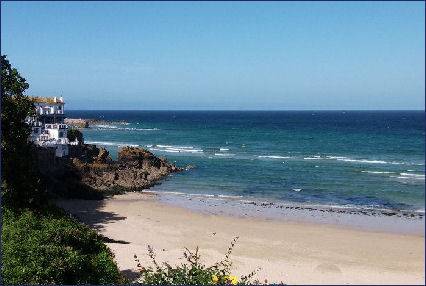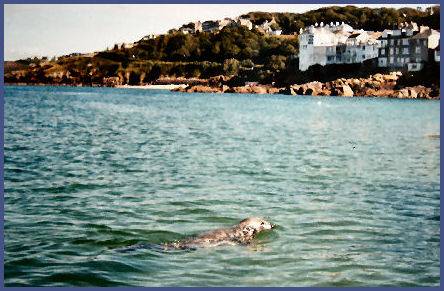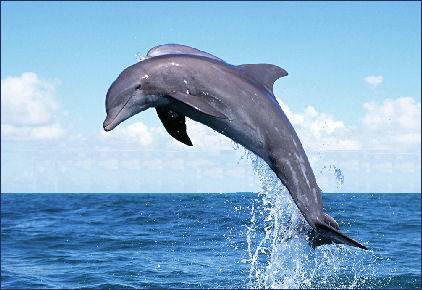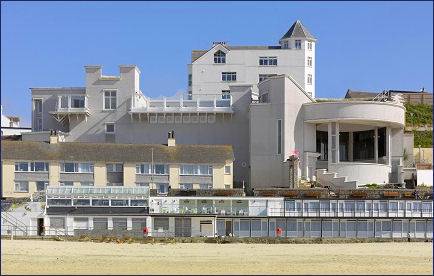St. Ives
OS Grid ref:- SW518403
 Colourful and characterful St. Ives, the artistic capital of Cornwall, is arguably one of the most popular holiday resorts in the county and boasts four beaches and a wealth of history and tradition.
Colourful and characterful St. Ives, the artistic capital of Cornwall, is arguably one of the most popular holiday resorts in the county and boasts four beaches and a wealth of history and tradition.
The town is situated to the north of Penzance and west of Camborne on Cornwall's Atlantic coast and has two main beaches, Porthmeor to the north, near to the Tate Gallery, is well suited for surfing, a surf school operates regularly on the beach and a hire centre is available for wetsuits. Lifeguards operate on the beach throughout the summer months.
The more family-oriented Porthminster Beach, just south of the harbour, is considered better suited for swimming and sunbathing. Dolphins, porpoises and basking sharks may be sighted in the Bay.
St. Ive's harbour retains much of its charm, as well as being a working harbour there is also an excellent sandy beach there which benefits from being in the middle of all the amenities of the town.The harbour beach backs on to the Wharf and Wharf Road which runs parallel to the town's main shopping street Fore Street. In the summer this is thronged with tourists drawn to the harbour and the range of cafes and shops that line the harbour front
Smeaton's Pier, situated on the northern side of St Ives harbour, was constructed between 1767 and 1770. At the beginning of the pier stands the diminutive St. Leonard's Chapel, where local fishermen would regularly pray before setting out on perilous voyages to sea and it is reputed, would donate a proportion of their catch to the chapel i thanksgiving for their safe return. The chapel is thought to occupy the site of a sixth century chapel founded by St. Ia. A large bronze plaque on the wall was added in 1959 and records the names of all the St Ives fishermen lost at sea.
St. Ives, known in Cornish as Porth Ia, meaning St Ia's cove, was founded by Saint Ia, an Irish princess and holy woman who was martyred in the fifth or sixth century. . She is said to have been , the sister of Saint Erc and a student of Saint Baricus. the town's parish church still bears the saint's name. The St. Ives Feast celebrating the founding of the town takes place on the Sunday and Monday nearest to the third of February.
St. Ives was, for centuries, a pilchard fishing port, by the middle of the last century the town boasted a fishing fleet numbered in hundreds of vessels. Life in the town still centres around its picturesque working harbour were fishing boats still moor.
The advent of the railway in
1877 transformed St Ives into a Victorian coastal resort, and much of the town dates to this period. The characterful old town has quaint stepped alleys and slate hung cottages
bedecked with an abundance of flower filled baskets. The mild climate of St. Ives and almost frost-free winters makes it possible to grow plants and shrubs normally native to semi-tropical countries.
The artist Turner visited St. Ives in 1811 to paint views of the town, in 1884 Whistler and Sickert visited and established an art colony there. In the 1920's and 30's, the quality of the light at St Ives's attracted such artists as Alfred Wallis, Ben Nicholson and Christopher Wood, sculptors Barbara Hepworth, Naum Gabo and potter Bernard Leach.
Throughout St. Ives many works by Barbara Hepworth are displayed, donated by the sculptress to the town. The Barbara Hepworth Museum and Sculpture Gardens is where contemporary artist's studios are now located.
 The St. Ives Museum holds many exhibits relating to the life and times of the town. Main collections include: art - paintings by the early artists of St Ives, blacksmith, boat-building, Crysede featuring hand-printed silk and linens, children's toys, ceramics, crafts and related tools, Cornish
kitchen, farming, fishing, geology, Hain Steamship Company, lifeboat, mining, St Ives railway branch line, Victoriana clothes, and unique photographs, some of which are over 140 years old.
The St. Ives Museum holds many exhibits relating to the life and times of the town. Main collections include: art - paintings by the early artists of St Ives, blacksmith, boat-building, Crysede featuring hand-printed silk and linens, children's toys, ceramics, crafts and related tools, Cornish
kitchen, farming, fishing, geology, Hain Steamship Company, lifeboat, mining, St Ives railway branch line, Victoriana clothes, and unique photographs, some of which are over 140 years old.
The oldest church in St. Ives is the medieval parish church in the Market Place, which dates back to 1434, the church has one of the tallest towers in Cornwall at 80 feet tall is built of massive Cornish granite stones brought by sea from Zennor, the base may be from an earlier church. The church bears an unusual dedication to a trio of saints; Andrew, Peter, and Ia.
The choir stalls have fifteenth century panels which may have been part of the original rood screen. In the churchyard just south of the tower is a very weathered fifteenth century cross, with a carving of God the Father upholding the crucified Christ.
 The interior contains a fifteenth century granite font and the nave boasts a beautiful wagon roof
with diagonal molding, curved bosses and intricate vine patterns. There are a very few fragments of mediaeval glass
in the north windows of the chancel and in the north east window of the north aisle.
The interior contains a fifteenth century granite font and the nave boasts a beautiful wagon roof
with diagonal molding, curved bosses and intricate vine patterns. There are a very few fragments of mediaeval glass
in the north windows of the chancel and in the north east window of the north aisle.
St. Ives has been the winner of the Britain in Bloom competition on many occasions. Fore Street is the most popular shopping street, packed with boutiques and unusual shops.
The St. Ives Feast celebrating the founding of the town takes place on the Sunday and Monday nearest to the third of February. The main St Ives festival is held in September every year and the New Year celebrations at St Ives are now world renowned
The town boasts a wealth of restaurants, pubs and accommodation to suit all tastes and pockets, including nearby campsites. The Sloop Inn, which lies on the wharf was a fisherman's pub for many centuries and dates back to circa 1312, making it one of the oldest inns in Cornwall.
Self drive boats can be hired from the harbour or there are various sea going excursions available to nearby Seal Island, where Atlantic Grey Seals can be often be sighted. Pods of dolphins, sun fish, basking sharks, majestic diving Gannets and Cormorants are frequently seen.
The Tate Gallery at St. Ives
Since the 1880's St. Ives has been a favoured spot of artists, including Walter Sickert and James McNeill Whistler among many others. The Tate Gallery in St. Ives was opened in 1993, standing above Porthmeor Beach. It provides the perfect place for appreciating the quality of light and coastal landscape which have drawn artists to St. Ives throughout the twentieth century.

The Gallery regularly displays exhibitions by the modern St. Ives School of Painters. Well worth seeing is the Barbara Hepworth Museum, on the work of the famous local sculptress.
Places to visit in St. Ives
* St. Ives Society of Artists , Old Mariner's Church, Norway Square, gallery overlooking the harbour. Open March - end of October, Monday to Saturday and Bank Holiday Sundays, 10am - 4.30pm.
Barbara Hepworth Museum and Sculpture Garden, Barnoon Hill, the sculptor's former home, where she lived until her death in a fire there, displays her sculptures, drawings and memorabilia. The studio is kept as it was in the artists day and is administered by the Tate Gallery.
*St. Ives Museum, Wheal Dream, artefacts covering all aspects of local life. Open, May - Sept, Mon - Fri, 10am - 5pm, Saturday, 10am - 5pm.